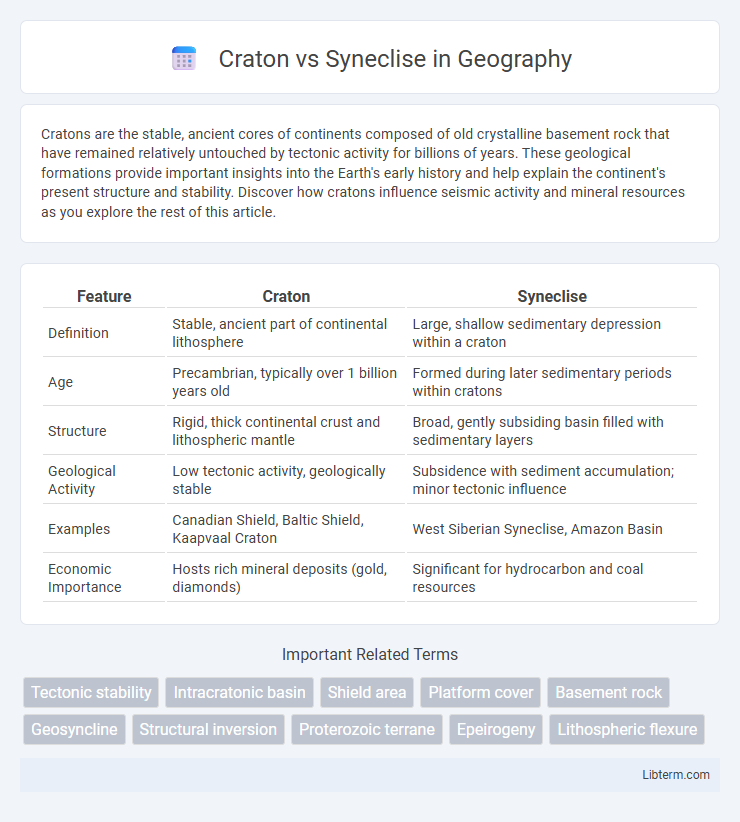Cratons are the stable, ancient cores of continents composed of old crystalline basement rock that have remained relatively untouched by tectonic activity for billions of years. These geological formations provide important insights into the Earth's early history and help explain the continent's present structure and stability. Discover how cratons influence seismic activity and mineral resources as you explore the rest of this article.
Table of Comparison
| Feature | Craton | Syneclise |
|---|---|---|
| Definition | Stable, ancient part of continental lithosphere | Large, shallow sedimentary depression within a craton |
| Age | Precambrian, typically over 1 billion years old | Formed during later sedimentary periods within cratons |
| Structure | Rigid, thick continental crust and lithospheric mantle | Broad, gently subsiding basin filled with sedimentary layers |
| Geological Activity | Low tectonic activity, geologically stable | Subsidence with sediment accumulation; minor tectonic influence |
| Examples | Canadian Shield, Baltic Shield, Kaapvaal Craton | West Siberian Syneclise, Amazon Basin |
| Economic Importance | Hosts rich mineral deposits (gold, diamonds) | Significant for hydrocarbon and coal resources |
Introduction to Cratons and Syneclises
Cratons are ancient, stable parts of the continental lithosphere that have remained largely unchanged for over a billion years, characterized by thick, rigid crust and a deep keystone mantle root. Syneclises are large, gently subsided sedimentary basins often found within cratons, formed by the gradual downwarping of extensive crustal blocks. Both cratons and syneclises play crucial roles in understanding Earth's geological history and the structural evolution of continents.
Defining Cratons: Characteristics and Formation
Cratons are ancient, stable parts of the continental lithosphere characterized by thick, buoyant roots extending deep into the mantle, typically forming during the Archean and Paleoproterozoic eons over 2.5 billion years ago. These geologically inactive cores consist mainly of highly metamorphosed crystalline basement rocks, providing a rigid foundation for continents that have resisted deformation and tectonic activity. Their formation involves processes such as mantle plume activity, crustal differentiation, and long-term thermal stabilization, distinguishing them fundamentally from younger, more deformed sedimentary basins like syneclises.
Syneclise Explained: Structure and Development
Syneclise is a large, gently depressed structural basin within a craton, characterized by its broad downwarping and sediment accumulation. Its development involves extensive subsidence due to tectonic forces, facilitating thick sedimentary sequences often linked to passive continental margin settings. The syneclise's stable, subsiding nature contrasts with the typically uplifted, rigid blocks of cratons, highlighting distinct structural and geological evolution.
Geological Composition: Craton vs Syneclise
Cratons are ancient, stable parts of the continental lithosphere composed mainly of highly metamorphosed Precambrian rocks, including granites, gneisses, and greenstone belts, reflecting their resilience to tectonic processes. Syneclises are large, shallow sedimentary basins typically filled with younger, less-deformed sedimentary rocks such as sandstones, shales, and limestones deposited over older basement rocks. The geological composition difference between cratons and syneclises highlights cratons' composition of crystalline basement rock versus the largely sedimentary cover found in syneclises.
Tectonic Stability and Evolution
Cratons are tectonically stable, ancient continental cores that have remained largely unchanged for over a billion years, characterized by thick, cool, and rigid lithosphere. Syneclises, in contrast, are large, gently folded sedimentary basins within cratonic regions that have undergone more recent and moderate tectonic deformation. The evolution of cratons reflects protracted stabilization processes, while syneclises represent sediment accumulation and subsidence associated with intraplate tectonics and basin development.
Global Distribution and Examples
Cratons are ancient, stable parts of the continental lithosphere found on every continent, including the Canadian Shield in North America, the Baltic Shield in Europe, and the Kaapvaal Craton in Africa. Syneclises are large-scale, gently depressed structural basins typically associated with sedimentary rock layers and are widespread in regions such as the West Siberian Syneclise in Russia and the Parana Basin in South America. The global distribution of cratons emphasizes tectonic stability and mineral wealth, while syneclises highlight sediment accumulation areas crucial for hydrocarbon exploration.
Economic Importance: Minerals and Resources
Cratons are ancient, stable continental cores rich in valuable minerals such as diamonds, gold, and platinum group metals, making them critical for mining industries. Syneclises, as large-scale sedimentary basins, often host significant hydrocarbon deposits including oil and natural gas, essential for energy production. Both geological structures contribute substantially to global resource extraction and economic development through their unique mineral and fossil fuel reserves.
Role in Earth's Geological History
Cratons are ancient, stable parts of the continental lithosphere that have survived multiple cycles of tectonic activity, providing a foundation for continental growth and preserving key geological records. Syneclises are large, gently depressed sedimentary basins found adjacent to cratons, playing a crucial role in accumulating sediments that reveal Earth's past environmental and tectonic conditions. Together, cratons and syneclises help geologists understand the processes of crust formation, stabilization, and sedimentation throughout Earth's geological history.
Key Differences Between Craton and Syneclise
Cratons are ancient, stable parts of the Earth's lithosphere, typically composed of old, rigid continental crust that has remained tectonically inactive for billions of years. Syneclises are large, downwarped sedimentary basins characterized by relatively younger, less deformed sediment accumulation over extensive areas. The key difference lies in cratons representing stable continental cores with thick lithospheric roots, while syneclises are subsided regions filled with sedimentary layers, often associated with tectonic downwarping rather than stability.
Conclusion: Significance in Geoscience
Cratons represent ancient, stable parts of the continental lithosphere, crucial for understanding Earth's tectonic evolution and resource distribution. Syneclises are large, gently subsiding sedimentary basins that provide insights into sedimentary processes and basin development over geological time. Distinguishing between cratons and syneclises enhances geological mapping, mineral exploration, and paleogeographic reconstructions essential for geoscientific research.
Craton Infographic

 libterm.com
libterm.com